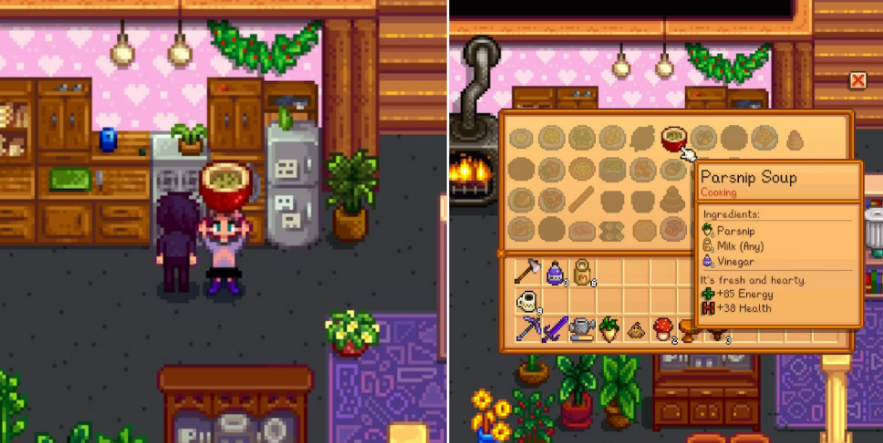Stardew Valley, the beloved farming simulation role-playing game, offers players a wide array of crafting options to enhance their farm and generate additional income. One of the lesser-known but valuable items you can produce is vinegar. In this guide, we’ll explore everything you need to know about making vinegar in Stardew Valley, from the basics to advanced techniques and its various uses.
Contents
- 1 What is Vinegar in Stardew Valley?
- 2 Prerequisites for Making Vinegar
- 3 Step-by-Step Guide to Making Vinegar
- 4 Best Ingredients for Vinegar
- 5 Profitability of Vinegar
- 6 Uses for Vinegar in Stardew Valley
- 7 Tips for Efficient Vinegar Production
- 8 Comparing Vinegar to Other Artisan Goods
- 9 Frequently Asked Questions (FAQ)
What is Vinegar in Stardew Valley?
Vinegar is an artisan good in Stardew Valley that can be crafted using specific ingredients. It’s a versatile item that can be used in cooking recipes, gifted to villagers, or sold for profit. Understanding how to make and utilize vinegar can significantly enhance your gameplay experience and farm economy.
Prerequisites for Making Vinegar
Before diving into the vinegar-making process, ensure you have the following:
- A Preserves Jar
- Fruits or vegetables
- Patience (it takes some time to produce!)
Obtaining a Preserves Jar
To make vinegar, you’ll need a Preserves Jar. Here’s how to get one:
- Crafting: You can craft a Preserves Jar once you reach Farming level 4.
- Materials needed:
- 50 Wood
- 40 Stone
- 8 Coal
- Alternative: You may also receive a Preserves Jar as a random reward from the Night Market submarine ride.
Step-by-Step Guide to Making Vinegar
Now that you have your Preserves Jar, let’s walk through the process of making vinegar:
- Place the Preserves Jar: Put your Preserves Jar in a convenient location on your farm or in a shed.
- Choose your ingredient: Select any fruit or vegetable from your inventory. Almost any crop will work!
- Add the ingredient: Right-click on the Preserves Jar with your chosen fruit or vegetable to add it.
- Wait for processing: The Preserves Jar will now start processing your ingredient. This takes 7 in-game days (6 days and 20 hours to be precise).
- Collect your vinegar: After the processing time is complete, interact with the Preserves Jar to collect your vinegar.
Best Ingredients for Vinegar
While you can use any fruit or vegetable to make vinegar, some ingredients are more cost-effective or easier to obtain than others. Here are some popular choices:
- Wheat: Cheap and easy to grow in large quantities.
- Corn: Another inexpensive option that’s available in multiple seasons.
- Tree Fruits: Apples, oranges, or peaches from fruit trees provide a steady supply.
- Foraged Items: Wild horseradish, spring onions, or salmonberries are free to collect.
Seasonal Considerations
Consider the following seasonal options for making vinegar:
- Spring: Parsnips, wild horseradish, salmonberries
- Summer: Hot peppers, blueberries, melons
- Fall: Cranberries, pumpkins, eggplants
- Winter: Winter roots, crystal fruit (if you have access to the Secret Woods)
Profitability of Vinegar
Vinegar can be a decent source of income, especially when made from low-value crops. Here’s a breakdown of the pricing:
| Base Price of Ingredient | Vinegar Sell Price |
|---|---|
| Less than 50g | 200g |
| 50g – 199g | 400g |
| 200g or more | 600g |
To maximize profits:
- Use the cheapest ingredients possible (e.g., wheat, corn)
- Consider the Artisan profession, which increases the sell price of all artisan goods by 40%
- Utilize the Preserves Jar to process crops during off-seasons
Uses for Vinegar in Stardew Valley
Vinegar isn’t just for selling; it has several uses within the game:
- Cooking: Vinegar is used in the following recipes:
- Coleslaw
- Fish Taco
- Salmon Dinner
- Gifting: Some villagers appreciate vinegar as a gift, including:
- George (Liked gift)
- Jodi (Liked gift)
- Pam (Liked gift)
- Quests: Occasionally, villagers may request vinegar as part of a quest.
- Tailoring: Vinegar can be used in the sewing machine to create the Cardigan clothing item.
Tips for Efficient Vinegar Production
To optimize your vinegar production in Stardew Valley, consider these tips:
- Batch processing: Set up multiple Preserves Jars to produce vinegar in large quantities.
- Use a shed or barn: Organize your Preserves Jars in a dedicated building to save space on your farm.
- Automate with Junimo Huts: If you have access to Junimo Huts, place them near your Preserves Jars for automatic harvesting.
- Plan ahead: Start processing vinegar before you need it for recipes or quests.
- Diversify: While focusing on vinegar, also consider producing other artisan goods like wine or juice for a well-rounded farm economy.
Comparing Vinegar to Other Artisan Goods
While vinegar is a useful product, it’s worth comparing it to other artisan goods to determine the best use of your resources:
| Artisan Good | Processing Time | Base Profit Multiplier |
|---|---|---|
| Vinegar | 7 days | 2x to 4x |
| Juice | 4 days | 2.25x |
| Wine | 7 days | 3x |
| Jelly | 3 days | 2x to 2.5x |
| Pickles | 4 days | 2x to 2.5x |
As you can see, vinegar has a competitive profit multiplier, especially for low-value crops. However, wine generally offers better profits for high-value fruits.
Frequently Asked Questions (FAQ)
To conclude our guide, let’s address some common questions about making vinegar in Stardew Valley:
Q: Can I use any crop to make vinegar?
A: Yes, you can use any fruit or vegetable to make vinegar in a Preserves Jar.
Q: How long does it take to make vinegar?
A: It takes 7 in-game days (6 days and 20 hours) to produce vinegar.
Q: Is vinegar worth making for profit?
A: Vinegar can be profitable, especially when made from low-value crops. However, other artisan goods like wine may offer better profits for high-value fruits.
Q: Can I gift vinegar to villagers?
A: Yes, some villagers like vinegar as a gift, including George, Jodi, and Pam.
Q: Are there any quests that require vinegar?
A: Occasionally, villagers may request vinegar as part of a quest, so it’s good to have some on hand.
Q: Can I use vinegar for anything besides selling and gifting?
A: Yes, vinegar is used in several cooking recipes and can be used in tailoring to create the Cardigan clothing item.
Q: Does the quality of the ingredient affect the vinegar produced?
A: No, the quality of the fruit or vegetable used does not affect the quality or value of the vinegar produced.
Q: Can I make vinegar in winter?
A: Yes, you can make vinegar in winter using stored crops, winter forage items, or greenhouse-grown produce.
Q: Is there a way to speed up vinegar production?
A: Unfortunately, there’s no way to speed up the vinegar-making process in vanilla Stardew Valley. The 7-day processing time is fixed.
Q: How does vinegar compare to pickles?
A: Vinegar generally has a higher profit multiplier than pickles, especially for low-value crops. However, pickles have a shorter processing time (4 days vs. 7 days for vinegar).
By following this guide and keeping these FAQs in mind, you’ll be well-equipped to start your vinegar-making journey in Stardew Valley. Whether you’re looking to diversify your farm’s products, complete specific quests, or simply try out new recipes, vinegar is a versatile and valuable addition to your artisan goods repertoire. Happy farming!

Alma J. Lillard is a passionate writer and gaming enthusiast who brings her deep love for Stardew Valley to every piece she creates. As a contributor to StardewUpdate.Today, Alma covers the latest updates, tips, and in-depth guides for players looking to enhance their Stardew Valley experience.

